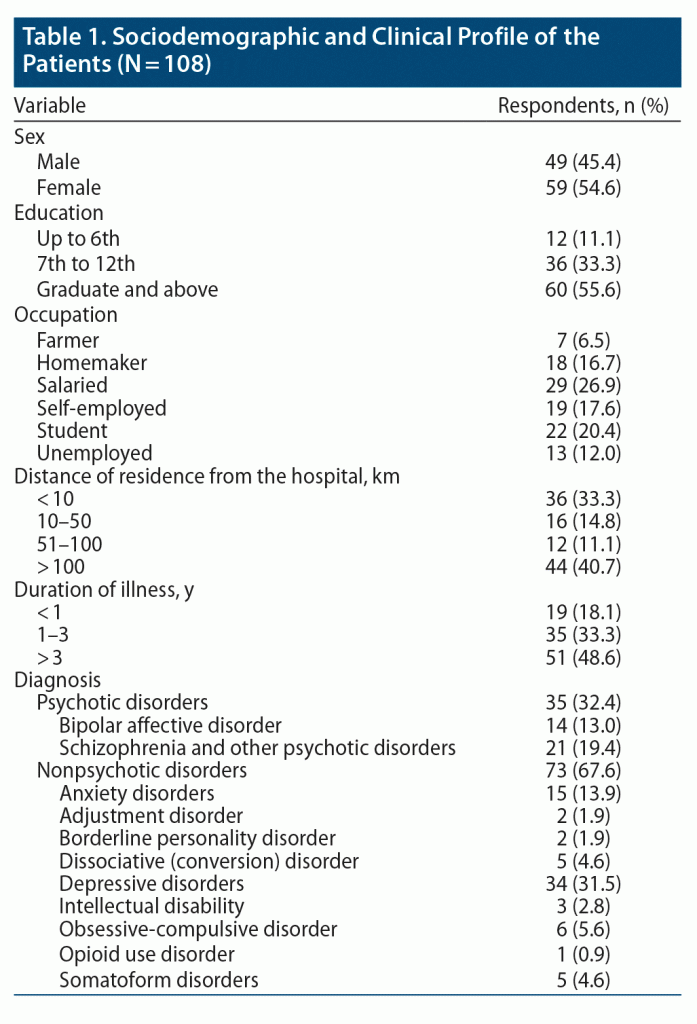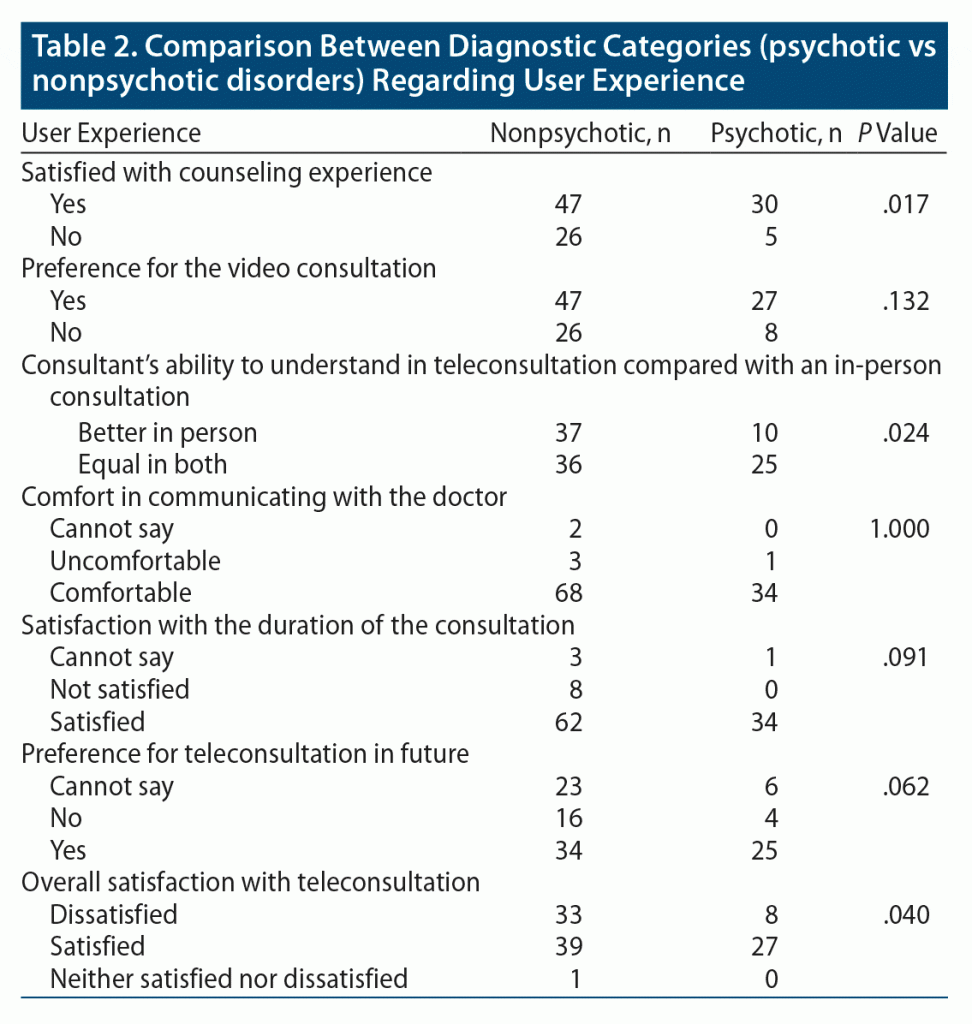ABSTRACT
Objective: To assess user perception regarding different aspects of the telepsychiatry process.
Methods: This cross-sectional survey study was conducted between July and September 2020 with follow-up patients attending teleconsultation at a tertiary care center (N = 108). The online survey included questions about the user’s experience such as the appointment process and different aspects of teleconsultation, as well as perceived benefits, difficulties experienced, and suggestions for improvement. The sociodemographic and clinical data were retrieved from the electronic record.
Results: The majority of patients expressed satisfaction with teleconsultation. The patients who were living far from the center (> 100 km) and those with psychotic illness favored telepsychiatry. Patients with nonpsychotic illnesses reported significantly less satisfaction with counseling in teleconsultation.
Conclusions: The findings substantiate the acceptance of telepsychiatry services and emphasize the need for a tailor-made hybrid form of consultation as per the patient’s profile.
Prim Care Companion CNS Disord 2022;24(5):21m03188
To cite: Swami MK, Mishra VC, Panda TK, et al. User perception of telephone-based telepsychiatry consultation: a cross-sectional survey. Prim Care Companion CNS Disord. 2022;24(5):21m03188.
To share: https://doi.org/10.4088/PCC.21m03188
© 2022 Physicians Postgraduate Press, Inc.
aAll India Institute of Medical Sciences, Jodhpur, India
*Corresponding author: Mukesh Kumar Swami, MD, All India Institute of Medical Sciences, Basni Industrial Area, MIA 2nd Phase, Basni, Jodhpur, Rajasthan 342005, India ([email protected]).
Telemedicine is an important tool to deliver services in a resource-limited setting.1 Telemedicine has become more accessible in recent years due to technological advances. The term telepsychiatry is used to specify psychiatric telemedicine services and includes assessment, management (both pharmacologic and nonpharmacologic), and follow-up of patients with psychiatric illness. In the Indian context, a huge treatment gap (83%) in mental health care is reported.2 This deficit can be attributed mainly to the limited number of psychiatrists. In addition, a high dropout rate of patients is also reported in psychiatric settings. The lack of mental health care in close vicinity is also an important factor that adds to financial burden and loss of time. In such a scenario, telepsychiatry services can provide an important avenue to target this treatment gap and is likely to improve follow-up rates and treatment adherence, ultimately improving the long-term outcome.
There have been some reservations regarding the efficacy of telepsychiatry during its earlier phase such as adequacy and reliability of assessment, difficulty in therapeutic alliance, and limitation in observation and nonverbal communication. However, many studies have suggested that telepsychiatry has satisfactory efficacy in assessment, diagnosis, management, and clinical outcome in comparison to in-person consultations.3–7
Apart from effectiveness, an important determinant in the adoption of telepsychiatry is the user’s perspective, as it influences the level of engagement. Studies8,9 examining satisfaction with telepsychiatry report high satisfaction among patients. A recent case report10 qualitatively examined perspectives of teleconsultation among inpatients and suggested that patients may find the experience impersonal and rushed in comparison to routine care.
In the wake of disruptions in health care facilities due to the coronavirus disease 2019 (COVID-19) pandemic, telemedicine services have increased exponentially. However, this is a new modality for the Indian population, especially in suburban and rural areas. Additionally, the success of teleconsultation requires motivation and initiative (belief in usefulness and efficacy of interventions delivered through teleconsultation) on part of the patient to reap the benefits, in the absence of which it can turn into a mechanical interaction (formal conversation with minimal input from the user’s side). Possibly, acceptability of such services can also be influenced by various sociodemographic (eg, locality, educational level, sex) and clinical factors. There are sparse data from India regarding users’ experience of telepsychiatry services. Such information can facilitate the formulation of tailor-made services. Thus, the objective of this study was to explore user perception regarding telepsychiatry consultation and its association with demographic and clinical factors.
METHOD
This cross-sectional survey study was conducted at a tertiary care center between July and September 2020 (during the first wave of COVID-19), as during this period only teleconsultation was provided by our institute (except in the case of emergency). The data were collected after approval of the institute’s ethics committee (no. AIIMS/IEC/2020/3117) through a 3-part online survey, which included informed consent, demographic details, and the questionnaire. Clinical details were collected from patients’ electronic records at the institute.
The survey included questions about the user’s experience such as the appointment process and different aspects of teleconsultation, including perceived benefits. The questionnaire also included 2 open-ended questions about difficulties experienced and suggestions for improvement. The final questionnaire was reviewed after the initial 5 responses were received so that any necessary changes could be incorporated; these responses were not included in the analysis.
The link to the online survey was sent to follow-up patients receiving teleconsultation with the psychiatry department (n = 283). Patients and their caregivers (for those patients who were unable to respond due to psychotic illness or intellectual disability) were requested through text message and telephone communication. Of these, 119 responses were received. Data for 11 patients were excluded due to incorrect details.
RESULTS
Among respondents (N = 108), 64.8% were patients and 35.2% were caregivers. Most of the patients were not working (unemployed, student, or homemaker), lived > 100 km away from the institute, were well educated, and had a long duration of illness (> 3 years) (Table 1). For ease of analysis, we divided diagnoses into broad categories of psychotic and nonpsychotic disorders.
A majority of patients reported the appointment process to be comfortable (85.2%), they received the desired appointment (85.2%), and they were satisfied with the waiting period (84.3%), duration of the consultation (88.9%), quality of care provided in teleconsultation (90.7%), and comfort while communicating in teleconsultation (94.4%).
Most respondents reported their counseling experience to be similar to in-person consultation (71.3%) and that they were able to understand the advice given during the teleconsultation (90.7%). However, 43.5% reported that the consultant’s ability to understand their problem was better with in-person consultation than teleconsultation, and 68.5% preferred video consultation to a telephone conversation. In-person consultation was reported as the preferred method by 38% of respondents.
There was no significant difference in response according to various sociodemographic and clinical variables except for broad diagnostic categories (Table 2). Patients with nonpsychotic disorders had significantly more dissatisfaction with the counseling experience (P = .017). They also felt that the consultant’s ability to understand their concerns was worse with teleconsultation compared with in-person consultation. Overall, these respondents were less satisfied with teleconsultation.
A significantly higher proportion of those living at a greater distance from the institute (> 100 km) reported teleconsultation was better (more convenient) compared with in-person consultation (P < .05). More educated respondents (graduate and above) reported the convenience of teleconsultation to be as good as that of in-person consultation, while a higher proportion of those with less education reported teleconsultation as more convenient (P < .05). Other sociodemographic and clinical variables were not significantly associated with the responses of the participants.
Most respondents reported saving time (58.3%) and being more convenient (22.2%) as the most important benefits of teleconsultation. Others reported comfortable interaction (5.6%), privacy (5.6%), and saving money (3.7%) as the main benefits. There was no statistically significant difference between the participants (ie, patients vs caregivers).
Some participants (< 15%) also mentioned difficulties with teleconsultation such as getting an appointment, change of consultant, and less duration of the consultation. One important suggestion was the need for in-person consultation after a few teleconsultation sessions, while other suggestions concerned logistics (registration process, timing).
DISCUSSION
The findings of this study substantiate the existing evidence that users were generally satisfied with telepsychiatry services. Additionally, the study provides a better understanding of the needs of telepsychiatry users.
The finding of a high level of satisfaction with telepsychiatry is similar to the existing literature.6,11–13 However, a recent study reported more satisfaction with in-person consultation.14 In our study, although most participants reported satisfaction with different aspects of the experience, they were relatively less satisfied with the quality of interaction (ie, perception of a lower ability of the consultant to understand and the counseling experience). This lower satisfaction was primarily reported by patients with nonpsychotic disorders. These patients usually receive more psychological interventions, and they compared teleconsultation to their earlier experience of in-person consultation at our center. In part, such perception may emanate from the inability of patients to receive nonverbal feedback from the clinician during teleconsultation compared with in-person consultation. These findings add to existing research suggesting an influence on rapport, lack of personal touch, and nonverbal cues in teleconsultation.15 The distance from the center emerged as an important factor when opting for teleconsultation, as the cost of travel (time and money) probably outweighed the benefit of in-person consultation. In addition, people living further from the center were mostly from a rural area and rely more on pharmacologic treatment as per our clinical observation. This could have influenced their choice, as they may have felt their need for psychological intervention to be low.
The findings of this study should be viewed with limitations including small sample size, response bias (ie, possibility that dissatisfied patients responded less), and use of broad diagnostic categories (ie, due to small sample). The patients in our sample actively sought teleconsultation due to ongoing symptoms, which might have resulted in bias.
The findings of this study cannot be applied to new patients presenting with acute illness, as most patients had a chronic illness, and only follow-up patients were included. It is important to explore user experience among new patients, as they are using a service with no background (prior exposure to a mental health facility, lack of rapport with the clinician) and have a different set of expectations. The impact on therapeutic alliance also needs to be examined systematically, as this is central to the practice of psychiatry. The findings may have been affected by the COVID-19 pandemic, thus further exploration post-pandemic is desired to establish patient preference (in-person, teleconsultation, or a hybrid model). We did not assess the clinical status of the patients that might have influenced the perception of the participants. Stable patients requiring only pharmacologic maintenance treatment are likely to have different needs. As per clinical observation, such patients tend to self-medicate to avoid frequent visits and may continue to take medications longer than necessary. Telemedicine can be useful in such patients for supervision of treatment.
As the main delivery mode of consultations was telephonic (video consultations were used very infrequently), the findings are not likely to apply to settings using video consultations. Apart from the mode of delivery, psychological mindedness and expectations from psychiatric services are also important determinants of patient satisfaction. Patients expecting improvement with only pharmacologic treatment may be more likely to be satisfied with teleconsultations for which difficulty with psychological interventions is a limitation. The contribution of stigma should also be explored. Patients can opt for telepsychiatry to keep consultations discreet and thus evade the stigma associated with hospital visits.
Despite these limitations, our findings provide important insight, as the patients were in follow-up, and they provided their perception of telepsychiatry in comparison with their in-person consultation experience. In addition, the present study also examined the effect of the patient profile (demographic and clinical) on their perception of telepsychiatry, which has received limited attention in earlier research.
The study findings emphasize that teleconsultation is a well-accepted model of consultation and an important tool to enhance the reach of mental health services and reduce the cost to patients, but its use should be individualized based on the demographic and clinical characteristics of the patients.
Submitted: November 12, 2021; accepted March 1, 2022.
Published online: September 22, 2022.
Relevant financial relationships: None.
Funding/support: None.
Clinical Points
- Teleconsultation should be used as an additional modality, especially for patients living at longer distances from the treatment center and those not requiring specific psychotherapeutic interventions.
- Patients with neurotic illness are more likely to experience dissatisfaction with telepsychiatry, so additional frequent in-person consultation may be needed.
- Frequent feedback from patients during teleconsultation can buffer the lack of personal touch to an extent, but this should be explored in further studies.
References (15)

- WHO Global Observatory for eHealth. Telemedicine: Opportunities and Developments in Member States: Report on the Second Global Survey on eHealth. [Internet]. World Health Organization website. Accessed July 10, 2021. https://apps.who.int/iris/handle/10665/44497
- Murthy RS. National Mental Health Survey of India 2015–2016. Indian J Psychiatry. 2017;59(1):21–26. PubMed CrossRef
- Modai I, Jabarin M, Kurs R, et al. Cost effectiveness, safety, and satisfaction with video telepsychiatry versus face-to-face care in ambulatory settings. Telemed J E Health. 2006;12(5):515–520. PubMed CrossRef
- Singh SP, Arya D, Peters T. Accuracy of telepsychiatric assessment of new routine outpatient referrals. BMC Psychiatry. 2007;7(1):55. PubMed CrossRef
- O’Reilly R, Bishop J, Maddox K, et al. Is telepsychiatry equivalent to face-to-face psychiatry? results from a randomized controlled equivalence trial. Psychiatr Serv. 2007;58(6):836–843. PubMed CrossRef
- Chipps J, Brysiewicz P, Mars M. Effectiveness and feasibility of telepsychiatry in resource constrained environments? a systematic review of the evidence. Afr J Psychiatry (Johannesbg). 2012;15(4):235–243. PubMed CrossRef
- Salmoiraghi A, Hussain S. A systematic review of the use of telepsychiatry in acute settings. J Psychiatr Pract. 2015;21(5):389–393. PubMed CrossRef
- Bishop JE, O’Reilly RL, Maddox K, et al. Client satisfaction in a feasibility study comparing face-to-face interviews with telepsychiatry. J Telemed Telecare. 2002;8(4):217–221. PubMed CrossRef
- Haxhihamza K, Arsova S, Bajraktarov S, et al. Patient satisfaction with use of telemedicine in University Clinic of Psychiatry: Skopje, North Macedonia during COVID-19 pandemic. Telemed J E Health. 2021;27(4):464–467. PubMed CrossRef
- Heyman-Kantor R, Hardy N, Corcoran AR. Patient perspectives on telepsychiatry on the inpatient psychiatric unit during the COVID-19 pandemic. J Patient Exp. 2020;7(5):677–679. PubMed CrossRef
- Hubley S, Lynch SB, Schneck C, et al. Review of key telepsychiatry outcomes. World J Psychiatry. 2016;6(2):269–282. PubMed CrossRef
- Hyler SE, Gangure DP, Batchelder ST. Can telepsychiatry replace in-person psychiatric assessments? a review and meta-analysis of comparison studies. CNS Spectr. 2005;10(5):403–415. PubMed CrossRef
- Simpson J, Doze S, Urness D, et al. Telepsychiatry as a routine service–the perspective of the patient. J Telemed Telecare. 2001;7(3):155–160. PubMed CrossRef
- Sehlo MG, Youssef UM, Elshami MI, et al. Telepsychiatry versus face to face consultation in COVID-19 Era from the patients’ perspective. Asian J Psychiatr. 2021;59:102641. PubMed CrossRef
- Olwill C, Mc Nally D, Douglas L. Psychiatrist experience of remote consultations by telephone in an outpatient psychiatric department during the COVID-19 pandemic. Ir J Psychol Med. 2021;38(2):132–139. PubMed CrossRef
Please sign in or purchase this PDF for $40.
Save
Cite





